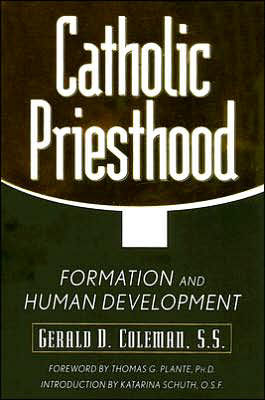
|
Posted November 7, 2006
Book: Catholic Priesthood: Formation and Human Development Author: Gerald D. Coleman, S.S. Liguori Press. Liguori, Missouri. 2006. Pp. 141 An Excerpt from Foreword:
Father Coleman then outlines many of the practical matters associated with human formation, sexuality, and celibacy. Finally, he focuses on problematic issues associated with formation, including the sexual-abuse crisis and related contemporary challenges to priestly formation. The work also contains several appendices that outline a code of ethics, how to take a sexual history, and warning signs of potential sexual abuse and sexual problems. Throughout the book, the author maintains a practical and matter-of-fact tone that presents a positive and inspired view of the priesthood, both now and in the future. Father Coleman balances issues related to the significant challenges facing the priesthood with the inspired call to serve God and the Church in such a selfless and courageous manner. He also merges academic and theological scholarship with very practical, down-to-earth issues facing priests today. The book is especially useful for anyone — seminarians, teachers, priests, or laypeople — who has an interest in the future of the priesthood in the United States. An Excerpt from the Book: Conversion is a lifelong process. If one can truly say “I am” at ordination and all the days which follow, one must be in a continual process of conversion. Human conversion involves several dimensions, each of which is important for the health of any vocation. Father Bernard Lonergan, S.J. describes three variations: Intellectual conversion: The development of new horizons, seeing life in radically new ways. Moral conversion: Overturning old values, former biases, and negative behaviors, substituting new values, habits of mind and behavior based on perceptions of intellectual conversion. Religious and grace-filled conversion: Development of a personal and behavioral horizon which moves to a world of knowledge and experience mediated by God, allowing oneself to be led into the hands of God. The priest is called to be a bridge-builder, a peacemaker, a reconciler, a mediator of unity. Only deep conversion — intellectual, moral, and religious — enables these goals to be achieved. The Basic Plan for the Ongoing Formation of Priests stresses the “new identity” priests must achieve as they move along through stages of their priestly life: after ordination, first pastorship and beyond, and finally into retirement. This plan identifies a threefold process — interior, exterior, and celibate — along with the temptations, graces, and discernment that accompany each dimension of the journey. Once again, the idea is that human formation is a lifelong process that involves the whole person (intellectual, religious, or other). Table of Contents: 1. The Call: “Come and See” 2. The response: “Becoming a Catholic Priest 3. The responders: “Who are today’s priests?” 4. Human formation: “Who you are and who you should be” 5. Human sexuality: “Definition and evaluation 6. Human sexuality: “Problematic Issues” 7. Celibacy: “Radical Discipleship |
|
